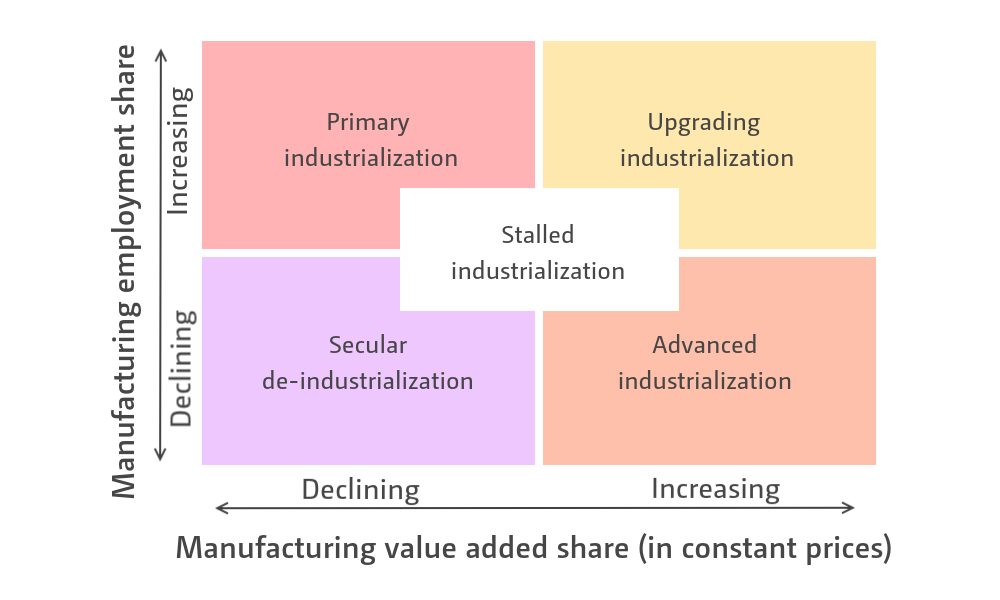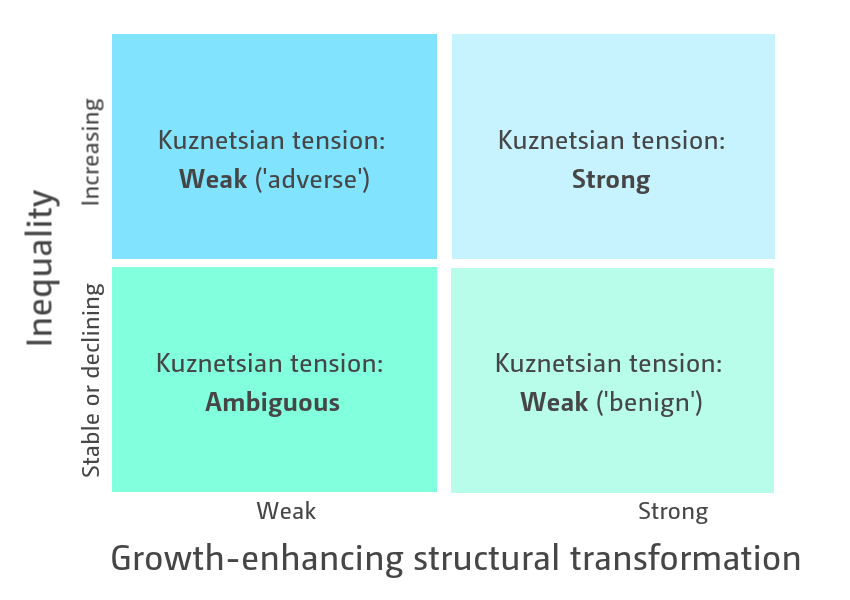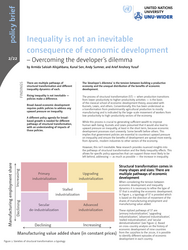Policy Brief
Inequality is not an inevitable consequence of economic development
Overcoming the developer’s dilemma
There are multiple pathways of structural transformation and different inequality dynamics of each.
Rising inequality is not inevitable — policies make a difference.
Broad-based economic development requires public policies to address any upward pressure on inequality.
A different policy agenda for broad-based growth is needed for different pathways of structural transformation, with an understanding of impacts of those policies.
The ‘developer’s dilemma’ is the tension between building a productive economy and the unequal distribution of the benefits of economic development.
The process of structural transformation (ST) — when production transitions from lower-productivity to higher-productivity activities — is the basis of the classical school of economic development theory, associated with Kuznets, Lewis, and others. Conventionally, this has been understood as a transformation from predominantly agricultural production to mostly manufacturing and is indicated by the large-scale movement of workers from low-productivity to high-productivity sectors of the economy.
While this process is crucial to generating sufficient wealth to improve human well-being, Kuznets and Lewis presumed that it would also lead to upward pressure on inequality, at least in the short term, because economic development processes start unevenly. Some benefit before others. This implies that government policies are essential to counteract upward pressure on inequality and ensure the benefits of development are spread more evenly, from dynamic, modern industries to other sectors of the economy.
However, this isn’t inevitable. New research provides nuanced insights into the pathways of structural transformation and the likely inequality effects. This allows for specific policy approaches that can support those most likely to be left behind, addressing — as much as possible — the increase in inequality.

Structural transformation comes in many shapes and sizes: There are multiple pathways of economic development
When considering the tension between economic development and inequality dynamics it is necessary to refine the type of ST that is enabling the economic development. In Figure 1, a typology of ST is provided which is based on the direction of movement of the shares of manufacturing employment and manufacturing value added.
These stylized pathways of ST are: ‘primary industrialization’, ‘upgrading industrialization’, ‘advanced industrialization’, ‘stalled industrialization’, and ‘secular deindustrialization’ (see Figure 1). Based on cross-country analysis on the history of economic development of nine countries from the 1950/60s to the 2010s, it is possible to identify different episodes of economic development in each country.
Our case studies were Brazil and Chile from Latin America, Ghana and South Africa from sub-Saharan Africa, Bangladesh and India from South Asia, and China, Indonesia and Thailand from East and South-East Asia.
Six of the nine countries studied experienced at least one episode of upgrading industrialization, characterized by a period of an increase in both the share of manufacturing value added and employment. Meanwhile five of the nine countries have experienced, at some point, an episode of stalled industrialization or deindustrialization. Few countries experienced primary industrialization — a period of rising employment share of the manufacturing sector, and declining value-added share — or an episode of advanced industrialization.
The time spent in any one quadrant varies also. Chile has experienced four decades of secular deindustrialization or stalled industrialization since the mid-1970s. South Africa was in the deindustrialization quadrant for more than 30 years since the early 1980s. In contrast, Indonesia, and Bangladesh both spent approximately 20 continuous years in the upgrading industrialization quadrant, Indonesia from 1975–1996 and Bangladesh from 2001–2018.
Each pathway of economic development has its own inequality dynamics and thus needs tailored policies

A second typology of inequality dynamics shows the potential inequality effects of different forms of economic development. For instance, primary industrialization can create employment opportunities, particularly so for low-skilled workers in manufacturing, resulting in an equalizing effect. On the other hand, stalled industrialization, upgrading industrialization, and deindustrialization could imply weaker job growth in manufacturing and an expanding modern and/or traditional service sector, which may be equalizing or unequalizing, depending on policies.
The political regimes do not appear to be deterministic in the case studies. Democracies are not necessarily better at managing the tension between ST and income inequality. Further, considering the bottom-right quadrant (see Figure 2)— the desirable place to be — of strong ST and steady inequality, we can see an East Asian story and a Latin American story. Finally, we can see that there are clearly some limitations to our approach related to group inequality — specifically racial inequalities — that need exploring further in the case of South Africa.
Conclusions: A policy agenda to link ST and inequality
Broad-based economic development requires public policies to address any upward pressure on inequality. This is exactly what Kuznets argued in his seminal paper, yet this has been mostly lost due to the excessive focus on the infamous, inverted-U curve. Public policies are needed to address any upswing in inequality and to spread the benefits of economic development to those people who need it most.
A strong policy focus on rural and agricultural development through public investments, technology, and a focus on food prices and availability can help to minimise urban–rural income divergence and upward pressure on inequality during ST
Education policy can help to minimise the higher skilled/lower-skilled worker income divergence (in short, re-distributing future incomes)
Unionization and agrarian reforms proved to protect lower-income workers
Access to other public services, including healthcare, housing, and social security has also shown to protect against increasing inequality
A different policy agenda that achieves broad-based growth for economies located in any of the quadrants requires understanding the inequality impacts of that agenda’s ST policies, as well as the ST impacts of that agenda’s policies aimed to address inequality.. Public policies remain essential not only to building a society, but also to building one that is foundationally more just.
 Join the network
Join the network